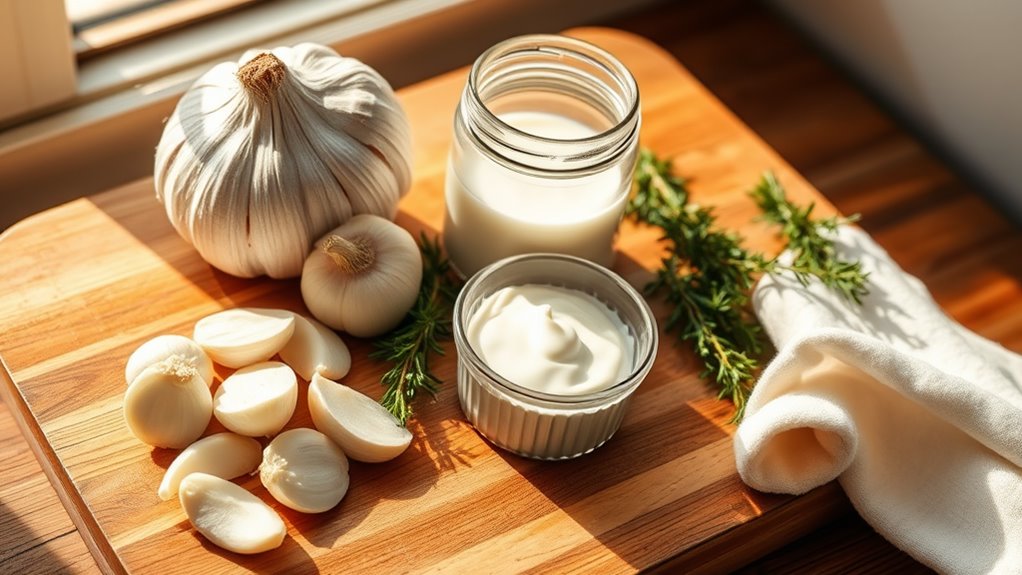Yeast Infection Remedies That Actually Work!
You can effectively treat a yeast infection with proven remedies that target the overgrowth of Candida fungus. Over-the-counter antifungal medications containing miconazole or clotrimazole offer quick relief, while natural solutions like yogurt with live cultures and tea tree oil can help restore balance. For immediate comfort, try an apple cider vinegar bath or coconut oil application. Your choice of treatment depends on your symptoms’ severity, and there’s much more to explore about managing these common infections.
Understanding Yeast Infections and Their Common Symptoms
Candida albicans, a naturally occurring fungus in the body, can multiply rapidly and cause uncomfortable yeast infections when conditions become imbalanced.
When you’re experiencing a yeast infection, you’ll likely notice intense itching, burning, and irritation in the affected area. You might also see redness, swelling, and a thick, white, cottage cheese-like discharge.
Many women face this common condition, particularly during pregnancy, while taking antibiotics, or when their immune system is weakened.
You’re not alone if you notice symptoms becoming worse at night or after swimming, sweating, or intimate activity.
It’s essential to recognize these signs early, as they’re often confused with other conditions. If you’re unsure about your symptoms, don’t hesitate to consult your healthcare provider for a proper diagnosis.
Natural Home Remedies for Yeast Infection Relief
When dealing with uncomfortable yeast infection symptoms, you’ll be glad to know there are several natural remedies you can try at home.
Natural yogurt containing live cultures can help restore balance to your vaginal flora – simply apply it directly or use a yogurt-soaked tampon. Tea tree oil mixed with coconut oil creates a powerful antifungal solution, while apple cider vinegar baths can help regulate pH levels.
You can also try consuming garlic, known for its antifungal properties, or drinking cranberry juice to help prevent future infections. Probiotic supplements support healthy bacteria growth, while coconut oil’s antimicrobial properties make it an effective topical treatment.
Remember to wear breathable cotton underwear and avoid tight clothing while using these remedies to speed up recovery.
Over-the-Counter Treatment Options
Several effective over-the-counter treatments are available to combat yeast infections without a prescription.
You’ll find antifungal medications in various forms, including creams, ointments, tablets, and suppositories. Most contain active ingredients like miconazole, clotrimazole, or tioconazole.
For quick relief, you can try one-day treatments that deliver a higher dose of medication. If you prefer a gentler approach, three-day or seven-day treatment options work well too.
When choosing your treatment, look for products containing vaginal cream applicators for easier use. Many brands also include external cream for itch relief.
Don’t forget to complete the full course of treatment, even if symptoms improve. If your symptoms persist after using OTC medications, it’s time to consult your healthcare provider.
Prevention Tips and Lifestyle Changes
Making simple lifestyle changes can significantly reduce your risk of developing yeast infections.
Switch to breathable cotton underwear and avoid tight-fitting clothes that trap moisture. After swimming or exercising, change out of wet swimsuits or sweaty clothes immediately. Keep your intimate area dry, and always wipe from front to back after using the bathroom.
Watch your diet by limiting sugar and refined carbohydrates, as yeast thrives on these foods. Include probiotic-rich foods like yogurt and kimchi in your daily meals. If you’re taking antibiotics, consider a probiotic supplement to maintain healthy bacteria levels.
Avoid douching or using scented feminine products, as these can disrupt your natural balance. Managing stress and getting adequate sleep will also help strengthen your immune system against infections.
When to See Your Healthcare Provider
Though many yeast infections can be treated at home, certain symptoms require prompt medical attention.
You’ll want to schedule an appointment if your symptoms don’t improve after a week of over-the-counter treatment, or if you experience recurring infections more than four times per year.
Don’t hesitate to see your healthcare provider if you notice unusual discharge colors like gray, green, or yellow, or if you develop fever, severe pain, or intense itching.
These could signal a different type of infection. You should also seek medical care if you’re pregnant, have diabetes, or aren’t sure whether your symptoms actually indicate a yeast infection.
Your provider can perform tests to confirm the diagnosis and prescribe stronger medications if needed.
Frequently Asked Questions
Can Yeast Infections Affect Other Parts of the Body Besides the Vaginal Area?
You can get yeast infections in many areas, including your mouth (thrush), skin folds, nails, and digestive tract. Wherever warm, moist conditions exist, yeast can potentially grow.
Is It Possible to Get a Yeast Infection From Wearing a Wet Swimsuit?
Yes, you can develop a yeast infection from wearing a wet swimsuit. The warm, moist environment creates ideal conditions for yeast growth, so it’s best to change into dry clothes quickly.
Can Men Transmit Yeast Infections to Their Female Partners During Intercourse?
Yes, you can get a yeast infection from your male partner during sex, though it’s less common. If he’s infected, it’s best to avoid intimacy until you’re both treated.
Do Antibiotics Always Trigger Yeast Infections, or Does It Vary by Person?
You’re not guaranteed to get a yeast infection from antibiotics, though they can disrupt your body’s natural balance. Some women are more prone to developing them than others after treatment.
Should I Continue Treatment After Symptoms Disappear to Prevent Recurring Infections?
You’ll want to complete your full course of treatment, even when symptoms clear up. This helps ensure the infection’s fully gone and won’t come back to bother you again.




